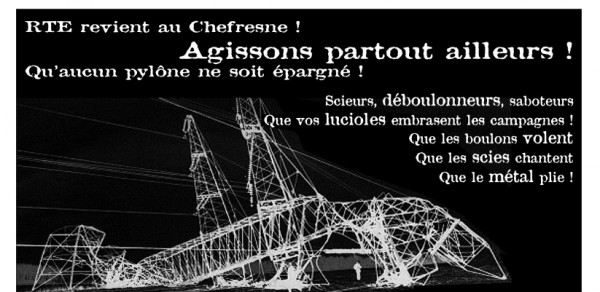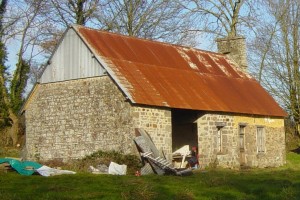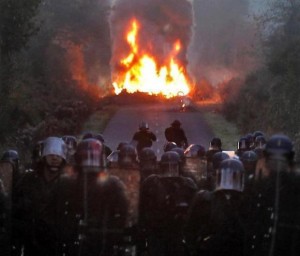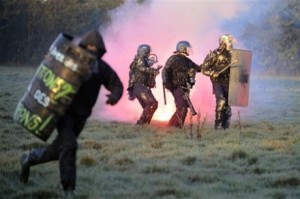Saturday, November 17th – Day of Reoccupation.
A yellow forklift truck leads the way; walking close behind is a block of Zadists carrying a fortified banner declaring: No to the airport and its world. Behind them 20 tractors pull huge agricultural trailers filled with building materials: piles of pallets, straw bales, tyres, doors, windows, prefabricated wooden walls, hundreds of planks, corrugated iron roofing, tools – pretty much anything you can think of, including kitchen sinks.
We sit on top of one of the trailers. The affinity group from our local village has decided to build one of the constructions for today’s reoccupation action – we have named it the Black Bloc Sanitaire – it’s a shower block and bank of compost loos. The pile of building materials that we sit on is much more messy than the trailer behind us which carries the wood for a group of young architects. The architects have a super neat stack of carefully numbered pallets and the rumour is that they have already practiced setting up their dormitory building in the main hall of the Nantes school of architecture. Our construction doesn’t even have plans that are to scale, but we are hoping that the collective energy of the day and a dose of spontaneity will see something rise from the pile of rubbish we are sitting on. This is the opportunity of a life time for anyone who has ever dreamt of building their own cabin, rebel palace or fortress: A free plot of land, no planning permissions or building regulations and hundreds of people keen to help build.
None of us know where we are heading, the location has been kept a secret. From high up we see the river of human being flowing behind us, snaking through the country lanes as far as the eye can see. As always, we have Radio Klaxon on in the background, they have just announced that the mainstream media think that there are 40,000 people are on the action and over 400 tractors! We are all here on an illegal demonstration whose aim is to build a rebel settlement together on the land earmarked for the airport (see part 1). Last night the president interrupted a state visit of Poland to make a statement about the protest, reminding the French public of the “power of the law.”
A year ago, when I first saw the flyer for this action, with its floating date to reoccupy 4 weeks after the first eviction, I thought it was a great idea but that it would be a handful of tired traumatised post eviction activists symbolically rebuilding a couple of huts. Little did I imagine I would be taking part in one of the largest act of mass disobedience I’ve ever experienced and that we would have enough material to build a hamlet. The fact that there is not a single police officer in sight, however, not even a helicopter watching above, is strangely disconcerting.
A “magic” clandestine group of farmers and activists chose the plot of land where the new buildings will be erected. The organising assembly (of over 150 people) decided by consensus that we should not squat land that already belonged to the airport builders (such as all the plots evicted over the past month) but work with one of the owners of the many private properties that is still in the process of expropriation. This would give the new settlement a stay of execution as the authorities would have to follow legal proceedings before destroying the buildings.
The tractor turns off the main road into a long straight potholed lane, we must be nearing the site. Jules, our local sheep farmer has been swigging beer bottles all the way. His hold atop our pile is becoming increasing precarious as the convoy stops and starts. The tractors grind to a halt and people start pouring into the field beside us, a huge blue circus tent is rising, a truck with a sound system is set up – its time to unload. A fortnight ago, at the dead of night, Jules and I were graffitiing a series of motorway bridges together. That night as we painted slogans announcing the date of the reoccupation we knew that something was in the air, that this day could be a game changer for the struggle of La ZAD, what we had not realised was that it would be a day that also changed us.
A newly cut path leads into the middle of a sprawling sweet chestnut coppice. Thousands of people are lined up either side of the track, shoulder to shoulder, forming human chains that stretch over half a kilometer from the tractors to the building site. Piece by piece, hand by hand, they pass construction materials along the lines. Planks, drainpipes, furniture, pots and pans, logs, bathtubs, stoves – everything one needs to build a settlement – all passed between so many strangers in the seemingly spontaneous effortless choreography of cooperation.

Within minutes the roots of trees are removed, hundreds of old car tyres are filled with earth for foundations and prefabricated walls begin to rise in the two clearings. People are swarming around the building sites brandishing tools, others look on in amazement. Frank, who is coordinating our team, kneels in the mud, our rough plans in his hands, he is staring at the 300 pallets flowing his way on a seemingly unstoppable human tide – he’s at a loss for words. The human chains just keep bringing material into the woods. I turn away to chat with Lucille about where to build our cob bathtub boiler, by the time I turn back around, another construction has risen up out of the crowd.
Within minutes the roots of trees are removed, hundreds of old car tyres are filled with earth for foundations and prefabricated walls begin to rise in the two clearings. People are swarming around the building sites brandishing tools, others look on in amazement. Frank, who is coordinating our team, kneels in the mud, our rough plans in his hands, he is staring at the 300 pallets flowing his way on a seemingly unstoppable human tide – he’s at a loss for words. The human chains just keep bringing material into the woods. I turn away to chat with Lucille about where to build our cob bathtub boiler, by the time I turn back around, another construction has risen up out of the crowd.

In the creative chaos no one seems to be bumping into anyone, nothing is being dropped or broken. There is a certain grace about self-organisation at this scale, a surprising suppleness of so many bodies working together. People are smiling, laughing, joking; they are sharing a sense of purpose yet feeling part of something so much bigger than themselves. This has become something much more than simply a rebel crowd, it has become an intelligent swarm fuelled by the irresistible spirit of disobedience.
The sun inches under the tree line. The sound of hundreds of hammering hammers fills the woodland. A field kitchen begins to cook. A medic’s tent has been set up next to a large tepee like structure rising up through the branches. In the woods, a group is weaving chestnut cuttings into what looks like the gate of a medieval fortress, we ask them to teach us how to do it and an impromptu wood weaving workshop takes place. In the clearing the architects have dug a well for water and are collecting bucket loads of clay. A Breton bag pipe plays and dozens of muddy feet dance joyfully on the straw and clay to mix the cob. Another makeshift team is cramming the mixture between the walls to form insulation for the dormitory, which is beginning to resemble a Swiss mountain chalet despite being built entirely of industrial pallets.
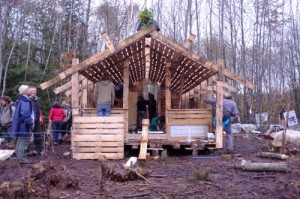
rom a neighbouring field comes the sound of a women’s choir singing: “La Java des Bons-Enfants” a catchy dance hall tune about an infamous 19th century anarchist attack with lyrics by Guy Debord, godfather of Situationism. “The radiant future is taking place” the song ends “and the old world has been sent to the junkyard”. Debord would have recognised the beauty of this moment, this passageway into the marvellous, where life takes on a passionate quality cracking the passive consumer spectacle of capitalism. Lucille turns to me “This is what our world should look like” a smile grows across her freckled face, tears edge across her eyes.

There are still no police to be seen but if their helicopters had looked down at the tens of thousands of people working across this landscape it would have resembled a convulsing ants nest, a purposeful self-managed organism without central command. They might have observed that out of the complexity of this multitude a collective intelligence was emerging, an intelligence greater than the sum of its parts. For those whose entire system is based on control and obedience, pyramids of power and hierarchies it would have been a frightening sight. The example of so many strangers cooperating in resistance is much more intimidating to the state than a burning barricade or a hail of cobblestones.
This is postcapitalism in its purest form – people creating together, organising without leaders, driven by the intensity of their passion rather than profit margins and merging work with pleasure. “ It seems that we are working perfectly well without bosses.” says Lucille as she moulds the clay around the bathtub with her hands, “could we have been lied to all our lives? ” she laughs.
The coming of the night does not stop the work; under head-torches, moonlight and generators the human chains and constructions continue. At the edge of the coppice beside the timber frame of one of the buildings brought by a crew all the way from Dijon (800 kms away), someone begins to set up a drum kit and a few amps. Improvised jazz accompanies the hammering late into the night, whilst in the fields opposite under the circus tent, hundreds pogo wildly in the muddiest of mosh pits to legendary Belgian punk band Rene Biname.
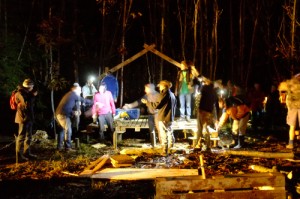
Monday November 19th
Jean is on his mobile phone when we arrive in his farmyard. He is discussing the media representation of the reoccupation – “Ok I better get back to my cows, see you later” He turns to us. “The mobile phone reception is getting worse, it’s got to be the cops”. Jean has a herd of 37 dairy cows. When the Zadists first arrived he was never particularly friendly. The strange breed of degrowth postcapitalist activists felt a million miles away from his life as a farmer. But little by little links were made, first over aperitifs, then through discussions about farming. The Zadists asked if he could reduce the chemicals he was spraying on the maize fields next to their cabins, he agreed and eventually began to test organic methods on some of his crops. Now he has become one of the many members of this fronline community of affected farmers whose solidarity with the Zadists has strengthened over the years. On the wall of his outhouse there is his complex milking timetable, next to it an anarchist poster declaring “NO to full time employment.”
We have come with Ishmel to help him move some of his belongings that have been stored in Jean’s attic since his house was destroyed last month. “I’ve got all sorts in my loft” Jean explains “solar panels, wind turbines, power tools. But mostly I have lines of washing. Nothing dries on the Zone, it’s so humid, the Zadists come here to dry clothes.”
There are already preliminary archaeological digs taking place on his land where the airports access roads are due to be built. “Last week the cops came with their bulldozers and I suggested a short cut to them – no need to take the road, you can go via the bottom of my field – I told them. They were really grateful for the tip.” He winks cheekily. “A few minutes later their commander walked back up here fuming. Their machine had sunk deep into the mud. It’s marshland down there! You don’t need much to resist, just a bit of local knowledge!” His hearty laugh chuffs clouds of steam into the cold December air.
In fact the humidity has become one of the resisters’ greatest helpers. Not only in terms of legal challenges around wetland disruption. The riot police in their heavy body armour find it hard to navigate through the thick mud and when a shower of well aimed sludge rains down onto their visors they become even more disorientated. All of them have been shipped in from afar, La ZAD is alien territory for them, they are used to policing streets, football stadiums and town squares, not forests and fields. It becomes particularly disconcerting for them at night when out of the dark woods comes the howl of wolves, emanating from the mouths of Zadists avoiding their road blocks by passing across country.
We move Ishmels belongins to his new home, a kitsch caravan lent to him by a local. “Someone gave me Jose Bove’s pipe last night!” Ishmel whispers.
“What?” Isa’s eyes nearly burst out of their sockets.
Bové was part of a group of green MP’s who on the eve of the reoccupation action broke into a boarded up building on the edges of la ZAD to symbolically “squat” it in front of a gaggle of press cameras. A radical farmer involved in the Larzac rebellion, infamously imprisoned for dismantling a McDonald’s in 1999 and more recently for anti GMO actions, he is now a green member of the European Parliament. His trademark symbols are his Asterix like moustache and pipe.
“We made bets” Ishmel continues – “200 euros for stealing Bove’s pipe during the reoccupation demo and 300 for Eva Joly’s signature glasses (Green Party presidential candidate). I don’t think anyone managed to grab the glasses.”
There has been heated debates around the role of political parties in the struggle. A year ago, before La ZAD became a household name in France, some local Green Party (EELV) MP’s had called the Zadists “violent agitators” and “extremists”. “These Ultras are totally autonomous, “ one of them told the press “we don’t know how to get rid of them.” The green party also kept silent on the airport plans following the presidential elections so that they would be given cabinet seats. Now they together with a bunch of bandwagon hitchers, are demanding the end of the evictions, but solidarity feels empty when you know that it is based on vote winning and popular opinion. The Zadist wanted Saturday’s action to be seen as a popular uprising, freed from political parties, they had asked that no one bring party placards or flags, the request was followed fairly well. Ishmale was part of a clown army who took on the role of throwing mud at those who refused – “the large red flags of the NPA (Trotskyist party) made easy targets” he jokes.
We return to the construction site. So many hands working together over the last three days have built miracles. The main structure of our Black Bloc Sanitaire is finished and we are putting the last touches to our wood fired boiler, there are two dormitories with working stoves, the large communal meeting room is having its windows fitted, the kitchen is filling up with donated vegetables and the workshop has a forge churning out catapults. There are even new plans for a bar christened No TAVerne (a reference to the No TAV movement against the Lyon-Turin high speed railway project).
The idea is that this new settlement temporarily named la Chât-teigne will function as a collective space from which to organise resistance to the airport. Other kit houses brought on Saturday, are still waiting to be put up on the zone for individual living spaces. La Chât-teigne will remain collectively run by all the groups who helped build it. On the improvised info board a chalk message reads: “Spare 20m square cabin ready – ring 067674196 to tell us where.” It doesn’t take long to find a home for it in the Rohanne Forest under the tree houses that have already been rebuilt since the evictions.
We work all day on the shower block. By late afternoon I start to feel peckish. I’m standing on the roof nailing the tin down when someone hands me a large platter of oysters, a bottle of cider and a joint: “This is what utopia looks like!” I quip. “..and it’s delicious!”
Friday 23rd November.
The morning is still, the dormant landscape is wrapped in the hush of winter. The new dormitories in the chestnut grove are packed with sleeping bodies snuggled up warm and cosy. The sun slowly limps above the horizon. Then the sound of smashing glass. Tear gas canisters are thrown into the dormitories, police officers scream. Everyone, including children, is pushed out into the cold. Simultaneously a kilometre down the road, hordes of gendarmes on foot bypass the new barricades by going via the fields. The first building to be squatted at la ZAD, an old farmhouse named Les Rosier, is rapidly evicted. The news travels fast, we jump in the car and head for the zone.
Isa and I arrive via a network of green lanes that don’t have police roadblocks on them. Radio Klaxon announces that bulldozers are on their way to La Chât-teigne and that Les Rosier is already half destroyed despite the ten farmers tractors blocking the farm yard. Are they really going to knock down La Chât-teigne even though the court case hasn’t gone through? 40,000 people helped build it, tearing it down will have an impact on so many people whose lives were touched by the magic of the reoccupation action.
We run through the fields and reach the Rohanne forest, it’s completely surrounded by gendarmes. There are over 500 on the Zone now, the area is totally shut down. We gather a small crowd and manage to break through a police line in the adjoining field, our hands raised in the air: “Only you are armed,” we chant. We burst into the forest. As we run we glimpse other bodies darting through the thick trees, dozens of figures all heading towards La Chât-teigne. We come across an affinity group huddled behind a tree covering their faces with chalky white anti tear gas lotion. “What’s happening?” I ask. “Its full on down there!” one of them replies “It’s war!” We keep going drawn by the crack of tear gas grenades.

The low winter sun’s ray’s bounce off the gendarmes shimmering shields. Hundreds of them ring the clearings. Bulldozers pulling hulking skips churn up the earth like entrails, trees have been flattened and the air is thick with tear gas. What was once a new rebel hamlet filled with life and creativity has become a battle zone. The collective kitchen is now a stockpile of wooden ammunition cases filled with tear gas grenades waiting to be shot at us and the meeting room has become the gendarmes temporary HQ.
Some people stand and talk to the police lines trying to reason with them, others try to approach the cabins from every angle charging out of the forest screeching. Sticks, distress flares and stones fly through the air, rubber bullets bounce off the tree trunks. “Put her in your sites” an officer in front of us commands his gun wielding colleague, “ that will get her to leave.” Isa freezes in fear. We turn around and take cover behind a coppiced chestnut tree. I’m beginning to be able to recognise the difference between the smoke trail arc of a teargas canister and a concussion grenade. “Put your fingers in your ears!” I scream, as one lands next to our feet and explodes in a deafening din. No wonder the birdsong has gone from the grove.
Ishmel runs up to us. “Apparently the operation is being run by the minister of interior himself ! They have announced that they are confiscating all the tools and building materials. Bu doesn’t look like they are going to flatten it today!” he says, as yet another concussion grenade ruptures the forest air. We tune back into Radio Klaxon, the minister of interior Valls has just told the press that the operation was to “stop a cyst from growing,” that he could not “let a base camp be installed, whose sole role was to lead violent actions”. Within seconds of his statement, twitter is alive with word plays, our favourite being “Valls – cyst my ass!” More and more people are arriving on the Zone, there must be well over 1000 resisting.

In the Rohanne forest hundreds use their bodies to block the bulldozers and specialised police climbing team from tearing down the new cabin and tree houses. It’s clear that the authorities would not be able to move the crowd without resorting to violence. When faced with civil disobedience tactics it seems they are less trigger happy especially with the media presence and shift in public opinion.
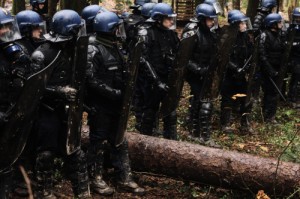
Evening falls, the gendarmes have stood around the immobile machinery all day and don’t want to be in the forest after dark. Their retreat is followed by a torrent of airborne mud and the cry: “We live here and we will stay here!” As we chase them out of the woods Lucille tells me about a new technique. If you aim the mud at the top of the knees, the ooze slides down between the leg and the body armour and means that the riot cop can’t bend his knees anymore. With a bit of luck he soon topples over like a playmobil character!
The diversity of tactics at la ZAD seems to be working and is clearly destabilising for the gendarmes. They never know whether they are going to walk around a hedgerow and meet a line of protesters using civil disobedience tactics, or face a hail of beer bottles from behind a barricade or an angry farmer blockading with several tonnes of tractor. At no point since the evictions have the farmers or the ACIPA (ngo) condemned the more militant tactics.
As we make our way to the evening coordination meeting, Radio Klaxon lists dozens of solidarity actions taking place across the country. Tractors have blocked the road bridges of Nantes and St-Nazaire and crowds are assembling in front of prefectures in over 30 cities. In St Affrique, Aveyron (700 kms away), the town hall is occupied and several councillors in favour of the airport have been locked in. In Paris an unauthorised demo has just ended with seventy-eight arrests. It seems that the ant’s nest has been well and truly disturbed!
Sunday 25th November. AM
My hands are still stinging as I type. I have washed them five times but the toxic tear gas molecules sink deep into ones pores. Whilst I was in the Rohanne forest I jotted down the company name and telephone number that was written on the side of one of the bulldozers. Given the fact that the drivers wear balaclavas to hide their identity, it seemed that someone had forgotten to cover up this interesting information. When I got home I emailed the details to La ZAD’s web site, which has a captivating minute-by-minute updated information time line. Within a couple of hours of the company details being posted online, they were forced to make a public statement claiming that they had sold that particular bulldozer to someone else. They claimed that they had been inundated with emails and telephone calls since the posting.
A few months ago there was a handful of local support groups against the airport, now there are over 180 and even if people are unable to physically be present on the Zone there are extremely efficient and simple forms of virtual resistance springing up. The job offer to do the pro airport public relations work on the internet’s social networks, had to be withdrawn following it leak – on social networks! Bogus enquiries for the job application to be sent out shoved a spanner into the employers bureaucracy.

The police operations on the Zone lasted from Friday to the early hours of Sunday morning with increasing state violence. On Saturday there were 400 people on the ground in the Rohanne forest, some courageously resisting by stripping naked and forming a human chain, but they were repressed and unable to stop the tree houses and cabins being evicted and destroyed. That afternoon 8000 supporters of the struggle took to the streets of Nantes facing a militarised city. As water cannons pummelled the crowd seemingly out of nowhere a communiqué arrived from the ministries of environment, transport and agriculture, saying that the forest clearance work that was due to begin in January, would be delayed for six months to makes sure all the environmental regulations were followed. Whilst confirming the “economic necessities for building the airport”, it said that until an independent group of scientists had made all the assessments on biodiversity, the clearance would not take place. Also mentioned was the setting up of a mission to work with locally affected parties to find ways to minimise the destruction of agricultural land.
Then later that night as the gendarmes attacked the barricades on the lane leading to the Chât-teigne, another government communiqué was sent out. This time from the airports champion, Prime Minister Ayrault. “ For the sake of appeasement” it said, the government had decided to set up a “dialogue commission” and was inviting those against the airport to come to the table. He did however make it clear that there was no doubt at all about the project being built!
Immediately ACIPA responded, they refuse to take part until all forces of order retreated from the zone, to which the minister of interior responded: ”There are never conditions to dialogue.”
As the clashes continued under blindingly bright police floodlights, a characteristic response to the “negotiations” was penned by a handful of Zadists. It had twenty one “non exhaustive, open demands”, these included: the closing of all companies with more than 12 employees, a life times income for all workers, twenty hours of sunshine in winter, nuclear energy replaced by ministers pedalling, the Élysée (presidents residence) transformed into a wetland, Valls and all members of the ministry of defence and interior to get “fuck the cops” tattooed on their foreheads, Pipe lines to be used only for transporting fruit juice, 60 acres of land be given to everyone who has ever lived on la ZAD and the final demand, “that all negotiations be made illegal” – perfectly rounding off this fitting response to the farce of democracy, where “dialogue” is not about resolving a problem but simply an exercise in saving face whilst continuing business as usual.
By Sunday morning when the police stopped their assaults and returned to their now customary roadblocks, 100 activists had been injured, many from direct hits by concussion grenades and rubber bullets. By law these have to be fired at 30 degrees in the air and not aimed at people. An outraged local doctor wrote to the ministry of interior listing the injuries. “ The shrapnel from grenade explosions, “sometimes up to a centimetre long” she wrote, could on entering the body have “reached arteries, nerves or vital organs”. Shocked she described how the ambulances were deliberately slowed down by police blockades.
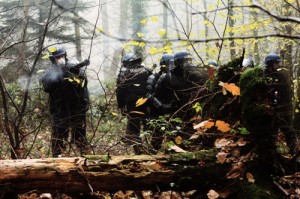
Sunday PM
A mass picnic has been called for Sunday lunch to continue to build La Chât-teigne. We arrive armed with bread, cheese, wine and a handful of tools, over 11,000 euros worth have been taken away by the authorities. Groups are busy picking up the thousands of tear gas canisters that litter the forest; there are plans to turn them into Christmas garlands to decorate socialist party head quarters. The settlement is still standing, a few windows have been smashed, our cast iron bathtub boiler has been broken in half, plumbing inside the bathroom has been damaged and all the bedding in the dormitories contaminated with CS gas. But hundreds of people have returned to bring back some utopian spirit to the chestnut grove. We get to work repairing, cleaning up and building an extra touch to the Black Bloc Sanitaire: a lookout tower! The familiar and reassuring sound of hundreds of hammering hammers has returned to the forest.
As we sit down to eat we hear that a few members of a group of elected councillors and MP’s (which numbers over 1000 and have named themselves strategically if somewhat humorously: The Collective of Representatives Doubting the Pertinence of the Project of Notre-Dame-des-Landes) have chained themselves to the railing of the prefecture in Nantes. They are demanding a meeting with the prefect, no dialogue can begin, they say, until all police operations stop on the zone.
A band arrives. They cross the churned up mire, carrying accordions, guitars and a small child on their backs. A police helicopter buzzes overhead, it must be observing the ants back at their rebel work. The band begins to play gipsy tunes. Then in the distance we hear the rumble of machinery. It’s heading towards us. It’s getting louder and louder. It sounds like dozens of huge engines approaching rapidly.
From the next-door clearing we hear a thunderous applause. It’s tractors, fifty of them! They have forced their way pass the police blockades and have come to protect La Chât-teigne. The farmers spend the rest of the afternoon chaining each tractor together in a ring. Real western style – circle the wagons! They promise to leave them there and set up a rotor for the weeks to come. Farmers from across the region together with activists will keep watch in the chestnut grove every night. Every time the state attacks us, the social ecology of this movement gets healthier; the unity in diversity flourishes and the movement becomes more and more resilient.
One of the most unexpected parts of this diversity is the group of 200 airplane pilots “doubting” the new airport. Some of them have been wondering why when planes approach the already existent Nantes airport, the control tower changes their course to pass over the heavily built up north of the city, instead of over the more rural south: ”We think it’s to incite the general public to want the airport moved elsewhere,” pilot Thierry Mason told Le Monde newspaper. A recent letter from one of them to the French president explains with solid statistics that due to the economic crisis, rising fuel costs (e.g. Peak oil) and the UN Kyoto CO2 commitments; all talk of future growth in European air traffic is a fiction, and this project useless. Some of the pilots fly over the Zone in micro-lights taking pictures. From the air, La Chât-teigne is looking more and more like Asterix’s rebel Gallic village.
Following the weekend overtures from the state, the prefecture promised to pull back all the police if: “all illegal construction stopped”. The Zadists refused through practice. The Zone has never seen so many new huts, tree houses and guerilla architecture popping up so quickly. Despite a ministry of interior decree that now bans all building materials from entering the zone there are nearly as many dwellings as before the evictions began. Laura from the Sabot is just one of the many Zadists who lost their homes in the first wave of destruction and has now rebuilt a cosy new hut. At La Chât-teigne more buildings are rising, including a children’s crèche and due to the numbers of people passing through, another dormitory, this time made from roundwood. In the middle of the lake on the other side of La ZAD there is even a floating cabin that you can only access by rowboat. The dynamic equilibrium of this movement has returned, the no and yes in balance. Everyday life has become inseparable from struggle, as activists plant vegetables, tractors become barricades, rioters become builders and architecture an act of disobedience.
On the day following the Prime minister’s call for dialogue, undercover cops masked up and dressed as activists infiltrated the middle of crowd behind a barricade. When the barricade was encircled and gassed by riot police and the crowd began to resist, the infiltrators broke cover. From the middle of the crowd they pulled out telescopic truncheons and arrested 5 people. One of them, named Cyrile, was sent to prison the following day for five months. Perhaps it was a last resort gesture, an attempt to throw the seeds of fear amidst us. Perhaps they wanted to awaken the cop in our heads, a cop that is much more dangerous than all the cops on the ground who for 3 months have failed to frighten us off.
Whatever it was, it backfired like every other brute state strategy. Cyrile’s letters written from his prison cell, now widely circulating online, show he is neither frightened nor broken: “ The common people mustn’t submit,” he wrote, “for this system is adrift. We are not far from running onto the rocks of global capitalism. We will not however leave this ship that can change course towards a better world. We aren’t its captains, but it is us who sail it. There is a reverberating alarm call throughout La ZAD. You can’t snuff it out forever.”
Navigating towards an unknown future is a beautiful way of describing a truly libertarian ecological politics, a politics where unity in diversity is fed by the power of natural spontaneity, the very key to all forms of evolution. In their worn out mechanistic logic governments still see managing the world as a game of chess, a dualistic strategy of opposing forces. Such logic of domination is an outmoded way of being in the world. Working against nature rather than with it and repressing the spontaneity of human and ecological systems, their thinking is as archaic as the grand construction projects built to control and shape the landscape in their like. The growing breed of revolutionary ecologists neither wants to dominate or surrender to the currents of the future, we just want to navigate them and create space for life to move on against the forces of extinction.
During the first week of evictions, I had an argument with some members of an affinity group who were cutting down a tree to make a barricade in an area where other activists had asked that no trees be felled. When I reminded the chainsaws wielding barricaders of this, they shouted at me arrogantly. “You have to break eggs to make an omelette, this is war you know.” “Anyway “ said one of them said “who cares! It’s all going to be concrete one day.”
“Why are you here then? “ I asked angrily. “If you think there is no chance of us winning then what’s the point of fighting? “. He shrugged and continued to cut into the tree. This toxic spirit of cynicism abounds everywhere. Normally, outside activists circles, it surfaces with words such as: “ Whatever happens they will do what they want!”, it’s such a powerful idea that it allows every sort of horror to take place and abandons the making of history to the hands of elites.
History shows us that the most powerful tool of rebellion is not the size of your party or the power of your weapons, but your ability to create the expectation of change. Insurrection is the art of feeding the imagination. Before October few doubted that the airport would be built, now thousands do and it’s contagious. In the days leading up to the Egyptian uprising local activists spent time in shopping districts warning women that something was going to happen and that they should stock up on emergency food for their family. Revolutionary expectation became embodied in the material realities of everyday life.
In the late 80’s few predicted how rapidly the changes would sweep across Eastern Europe, leading to the collapse of the Eastern Bloc. Most experts looked at the balances of power, e.g. social movements size versus the state apparatus, what they ignored was that it’s the expectation of change that has most power. Even if it seemed an impossible contest on the ground, once the minds of a population had radically changed anything could happen.
To commemorate the 20th anniversary of the fall of the wall, the BBC asked people in 27 countries if capitalism was working well, only 11% of those questioned said yes. Nearly one in four said it was a fatally flawed system and that another economic system was needed. It seems most of us now expect something different on the horizon. The problem is that we find it hard to imagine what something else looks and feels like, perhaps somewhere amongst the complex diversity of La ZAD we can find clues and directions, new maps and currents.
When the banner “Cesar you seem to be stuck in the mud!” was put up on the zone as the evictions began to go wrong, few thought that even some of Cesar’s (the name of the police operation) soldiers would turn against their leaders.
Days after the last offensive, the main police officers union published a flyer protesting at the work conditions at Notre-Dames-des-Landes. The officers complained of too long hours, acute tiredness, disorganisation and too much central command. An officer specialising in public order later admitted that given the “appropriate means” they could clear the entire Zone but that whatever happens it would be impossible to hold the territory: “we cannot stop people returning at night or the next day” he told the Telegramme newspaper. In his eyes there may have to be a permanent police presence from now till 2017 when the airport is due to open, but the extra costs will be astronomic.
The rise in security costs was one of several factors that decimated UK prime minister Margaret Thatcher’s megalomaniac road building programme in the 1990’s. Following protest camps on numerous road sites – in the trees, on the ground and underground, with ingenious networks of tunnels inspired by the Vietcong; the British government cancelled 700 future projects. In an economic dictatorship, where balancing the books is more important than saving the climate this insane airport has more chance to be stopped because the budget doesn’t stretch than because of its ecosidal impacts.
POST SCRIPT
On the 11th of December, the court signed the destruction order for La Chât-teigne, the legal team responded saying that as numerous people actually lived there they would also need an expulsion order before they came in with bulldozers. Just as the news of the order came out a press release by the prefecture, claimed that a police squadron had been “ambushed” by “fifty helmeted assailants wielding shields, Molotov cocktails and sling-shots.” Yet another attempt at criminalising the movement and breaking the precious links of solidarity floundered when a farmer told French radio: “We respect their way of fighting. The violence comes from the police.”
Over a month later and the eviction has still not materialised, La Chât-teigne remains a hive of activity and each week a different support group from somewhere in France takes turns to run the hamlet and devise a week of events. There have been workshops in everything from samba dancing to Japanese Tanuki mask making, film screenings, photo exhibitions, gigs and discussions. In a few months time as the soil heats up, seeds will begin to sprout in the huge poly-tunnels that have been put up nearby.
As I finally finish this long overdue update a three-day festival “ManifestZAD”, with radical rapper Kenny Arkana headlining is ending. Despite another decree written to disrupt us, this time banning the erection of any marquees and police attempts to block food, water and other resources entering the festival site – 20,000 people braved winter weather and acres of mud to party against the airport and its world.
I have rarely laughed so much as we did that night, trying to dance and move in the ooze. It was so sticky that we kept getting sucked deep down into it, unable to move our legs anymore we were paralysed by the grip of the earth, our bodies moulded by mud. At one point I had sunk so far it took three grown men to pull my abandoned boot out. All we could do was to laugh. And amongst the classic slapstick scenes there was a spirit of solidarity that seemed unbreakable. Strangers became friends helping each other free themselves from this goo of life, this humid soil which is ultimately the living foundations of everything that feeds us, clothes us, enables us to breathe.
On la ZAD that night we were becoming mud, becoming part of this dark complexity a teaspoon full of which holds four billion micro organisms recycling death into life for us all everyday. The word humble has its roots in humus, it means to literally return to earth. Perhaps the future will be built by heroic acts of humility rather than arrogant temples to growth. Perhaps civilisation’s dream to suck this Zone dry with its concrete and tarmac, steel and plastic will be vanquished by wetness.
“We don’t want to occupy the territory, we want to be the territory.”
The Invisible Committee, The Coming Insurrection.
Photos by JJ and Pan
